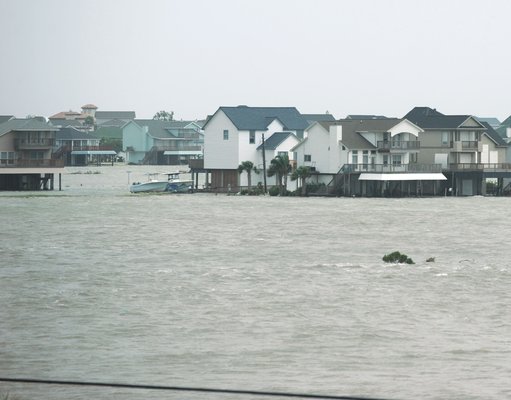
by Mary Caperton Morton Thursday, January 5, 2012

Waters rise in Galveston, Texas, as Hurricane Ike approaches. FEMA
On Sept. 12, 2008, Galveston was a picture-perfect seaside Texas town, with an extensive stretch of beach lined with beautiful homes. But a day later, when Hurricane Ike roared across Galveston Island, the storm surge flooded the barrier island, washing away houses, roads and tons of beach sand. Now researchers have figured out where all that sand went.
Galveston Island, like other barrier islands, has no hard rock foundation. From top to bottom, it’s all sand and sediment, dumped into the Gulf of Mexico by the Mississippi River and transported by offshore currents to the Texas coast. Hurricanes and storm surges are part of the natural life cycle of such islands, but until now, the role storms play in building and eroding Galveston had not been well quantified, says John Goff, senior research scientist at the Jackson School of Geosciences at the University of Texas in Austin.
“Storms can either bring additional sediment to barrier islands or they can carry sand out to sea, where it is lost,” says Robert Morton, a coastal geologist with the U.S. Geological Survey in St. Petersburg, Fla., who was not involved in the new study. When storm surges wash over barrier islands, they often leave behind a layer of sediment that builds up the land, Morton says. But more powerful storms can have the opposite effect, he says. The surge water drains back out to sea, gouging out sand and sediment from the coastline and carrying it out to sea.
To study Ike’s give and take, a week and a half after the hurricane made landfall, a team of geologists from the University of Texas led by Goff set out to map the seafloor around Galveston and the neighboring Bolivar Peninsula using sonar, seismic instruments and sediment cores. Fortuitously, the team had already mapped the same area a few months before as a teaching exercise, giving them a rare opportunity to compare the region before and after the hurricane.
“Our ultimate goal was to create a sand budget to find out how much sand
was removed from the barrier island system and determine exactly where
it went,” Goff says.
Comparisons of the two mapping studies revealed dramatic changes in the
bathymetry of the seafloor around Galveston, including significant
reshaping of centuries-old sediment basins and underwater shell-gravel
ridges; the appearance of deep erosional pits; and a huge apron of sand
blanketing the area as far as tens of kilometers offshore. “It’s a very
thin layer, but if you add up the volume, given the area, it’s a
substantial amount of sand that was removed from the barrier island
system,” says Goff, who plans to publish the team’s findings in the near
future. “Once it’s out to sea, that sand is in an erosional environment
and too far out to be reincorporated back into the island.”
“Galveston was already in a narrowing phase before Ike; both the Gulf side and the landward side were eroding,” Morton says. “The island is a few miles wide so it will be a long time before it disappears, but powerful storm surges definitely speed up the erosion.” The community needs to seriously reconsider whether to rebuild in such hazardous areas, he adds.
So far, the University of Texas team has conducted three post-Ike surveys of the seafloor around Galveston, including Bolivar Roads, the high-traffic shipping channel between Galveston Island and the Bolivar Peninsula. They plan to extend their maps this summer when weather conditions off the coast improve.
“The bottom line is that Galveston and the Bolivar Peninsula have been tremendously denuded of sediments that aren’t going to be replenished naturally any time soon,” Goff says. If the community wants to rebuild the beaches, he says, they will need to mine sand somewhere else and replace the beaches manually —a difficult, and expensive, task.
© 2008-2021. All rights reserved. Any copying, redistribution or retransmission of any of the contents of this service without the expressed written permission of the American Geosciences Institute is expressly prohibited. Click here for all copyright requests.